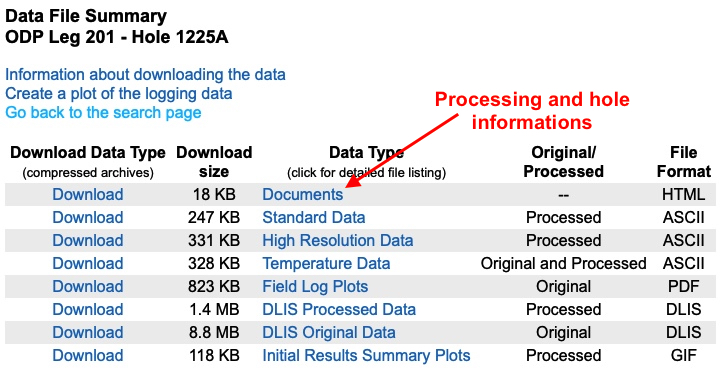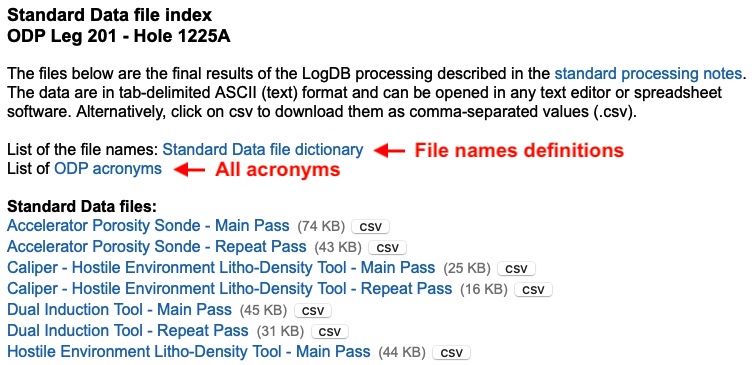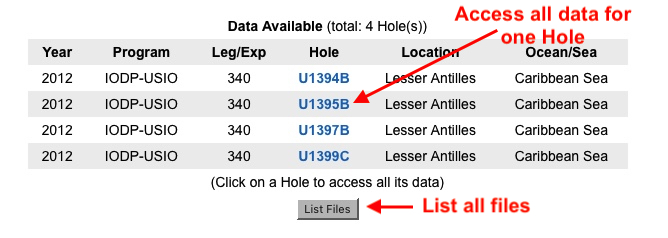Frequently
Asked Questions
Q. The hole I am interested in is not included in the log database. Is it missing ?
A. If the hole you are interested in is not listed, then no logging data were collected in that hole. For DSDP/ODP/IODP holes, core data from that hole are available through IODP-TAMU at http://web.iodp.tamu.edu/OVERVIEW
or http://iodp.tamu.edu/database.
Q. I cannot access the hole that I am interested in. It looks like I need a password.
A. All IODP holes are subject to a 1-year moratorium after the final sampling. During this time, only members of the shipboard party have access to the data. At the end of the moratorium, the data becomes available to the general public.
Q. In the case of password-protected data, do I need a different username and password to access the IODP core database ?
A. No, the same username and password for one expedition work on all databases.
Q. Where can I get information about the processing performed at each hole ?
A. The Documents section of each index page contains detailed information about the processing performed for each dataset at a particular hole:
Q. I am not familiar with logging tool acronyms. Where can I find their definition ?
A. The list of all the acronyms is available in the Documents section in the Data File Summary page for each hole, as well as a link from the index page for
each data type. The list of the definitions of all the data files of each hole is also available as a File Dictionary link at the top of each data type index page:
Q. I am searching for the data types of a specific hole and I have come up with a page-long list of individual files. How do I get a list of the data types available for a specific hole ?
A. To get a list of data types instead of individual files, you must click on the active link for the hole in the search results page. It will take you to the Data File Summary page for this hole.
Q. Is any industry-standard format available in this database ?
A. The DLIS (Digital Log Interchange Standard) is available for both original (raw) and processed data.
Q. I am looking for data in LAS format.
A. Because most users don't have access to software than can read technical formats such as the Log ASCII Standard (LAS), the processed data are provided in a simple text format (or alternatively as
column separated value, csv) than can be imported in any spreadsheet or data analysis software. If you are using a software that can read
LAS format, it will also likely read the DLIS files provided for each hole (processed and raw data). If you definitely need data in the LAS format, you can use the Schlumberger Log Data Toolbox (Windows only) to extract the data that you need from the DLIS files provided and export them into LAS files.
Q. How can I load and interpret image data from the processed DLIS files?
A. The images in LogDB have all been processed and depth matched with other runs/passes in the same hole, but various arrays in the processed DLIS files need to be recombined before being able to display and interpret the images. The procedure is different for each type of tool, but the main steps are described in this procedure to display processed FMS images in TechLog.
Q. Where can I get information about the logging tools currently used in the logging program ?
A. You can find a description of the tools and their applications on our logging technology page.
However, no description is available for tools used during the IODP-CDEX and IODP-ESO expeditions.
Q. Where can I get information about the logging tools that are no longer used in the logging program ?
A. You can find a description of most 'legacy' tools and their applications on our logging technology page or on the Downhole Measurements section of the ODP Legacy portal. However, no description is available for most tools used during the Deep Sea Drilling Project (DSDP).
If your question was not answered, feel free to send an email to LogDB Support at the Borehole Research Group.



